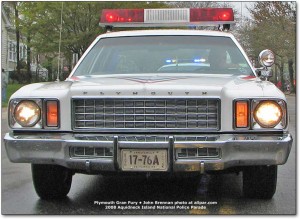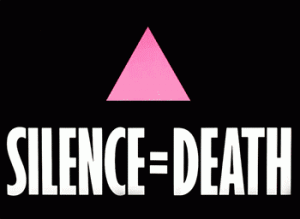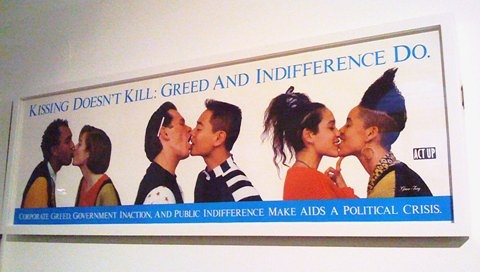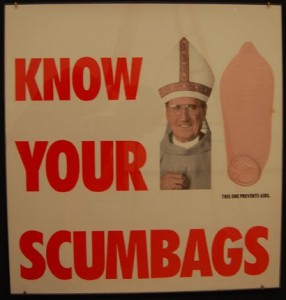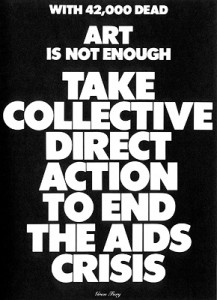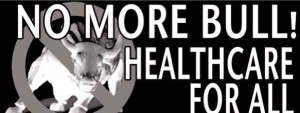ACT UP NEW YORK: Activism, Art, and the AIDS Crisis, 1987 – 1993,
Lest we forget the Gran Fury was not just a car. It was also the name of the propaganda ministry for ACT–UP. It was Gran Fury, having stolen the name of the standard issue cop car of the day, the Plymouth Gran Fury, that coined the phrases, designed the logos and generally set the rhetorical tone for one of the most visible activist movements of the late 1980’s through the mid 90’s. Take the gloves off –a chant hurled at begloved cops across the nation as they dragged protesters from sundry intersections, White House lawns, the New York Stock Exchange, George Bush’s Kennebunkport Manse etc., etc – was the M.O. of the entire movement. In an era when homophobes in government, the media, the Catholic church and the medical establishment peddled notions like gay cancer the agit-prop of Gran Fury/ACT_UP sought to turn the tables and to save lives.
White Columns current show, ACT UP NEW YORK: Activism, Art, and the AIDS Crisis, 1987 – 1993, curated by Helen Molesworth and Claire Grace is a sprawling presentation of video recordings, posters, crack and peel stickers, T shirts, and miscellaneous graphic material all framed by the entryway installation from fierce pussy and the glaring electric sign urging “call the white house, 202 456 1414 tell Bush we’re not all dead yet”.
Video recordings dominate the gallery space. Eighteen monitors offering a sometimes somber, sometimes energizing presentation of talking heads. This is the ACT UP Oral History Project developed and produced by Sarah Schulman and Jim Hubbard. It presents interviews with more than 100 surviving members of ACT UP.
It must be said that this is a difficult show to engage with. In its capacious reach it offers such a great density, complexity and utter volume of material it tends to overwhelm. To begin with there are many, many hours of interviews. One can spend a great deal of time seated on small stools face to face with the talking heads of one ACT UP activist after another. For me the show became something like a hypertext link to a sprawling complex of online information, with a facebook page, twitter feeds and the complete transcript of all the ACT UP Oral History Project interviews available at www.actuporalhistory.org. The show very explicitly and appropriately corrodes the boundaries of the gallery space; it takes the message out into what might be the contemporary street: the internet.
Additionally the project in its entirety has been donated to the New York Public Library rare books collection where it is available copyright free (nice way of smuggling a touch of radical activism past the lions) and is, according to Stephen Shapiro, the most frequently asked for material at the NYPL. And the whole thing isn’t over! It is also an ongoing project with ambition to include many, many more hours of interviews.
So what can we retrieve from all this material? A history of the art world’s engagement with radical activism in a given moment? Yes in part. White Columns reminds us that it was, along with some other New York arts organizations, an active partner with ACT UP. (As was the New Museum before it became an annex for wealthy collectors.) Mostly though I think it is the engagement of individual artists and intellectuals, rather than institutions, and the manner in which said individuals reshaped the institutional and public response to the AIDS emergency.
For most of us it is the slogans and posters that we remember. This is because the whole ACT UP enterprise incised a space for itself in public consciousness through the mutual caress of pith and politics. Cultural critic, and ACT UP activist, Douglas Crimp, one of the interviewees, argues that one of the great talents of ACT UP was to allow slogans to “graphically and textually … constitute a certain complexity”. Thus silence = death with the pink triangle while not quoting, does certainly allude to a history of gay life where pink triangles and death had a currency. Does it equate then and now? Well no, not exactly, but by circulating such inflammatory conjunctions it threw the now into the shadow of the then. Similarly the New York, MTA bus posters (below) appropriated the space of seduction/consumption to resignify the purpose of that very space. Don’t buy it, was the subtext. Oppose it was the literal message.
Nor did ACT UP’s graphics shy away from confronting their explicit enemies. The rhetoric of “know your scumbags” was of course incendiary and by burning their enemies so, they kept their struggle very visible and audible. And too, like all good agitators, there was even self-critique to direct their audience toward the real action to take:
Many of the talking heads reminisce ‘war stories’. Arrests here and there. Attacks by cops everywhere. And, inevitably, there are many mentions of those who are not talking heads: the ones who did not survive. In fierce pussy’s installation sloganeering and mourning cohabit in lines like “if she were alive today you’d be so her type” and “if he were alive today he’d still be living with AIDS”.
Yet it is not the case that the movement was crushed by its own losses or blinded by its own mourning. It is clear that the broader implications of the emergency for health care as a whole became a copilot for much of the project of ACT UP. The status of a private, for-profit, health care industry, including giant pharmaceutical corporations, were an integral piece of the protest. Thus with the availability of the first effective, government sanctioned treatments we saw ACT UP explicitly confronting capitalism’s hand in the crisis. When Burroughs Welcome (now disguised as Glaxo, Smith, Kline, customer.relations@gsk.com ), introduced AZT in 1989 at $8,000 per person, per year the protest were an immediate and loud attack of Wall St in general and Burroughs Welcome in particular. The protests also continued. As recently as 2007 it was ACT UP that organized a rally to march on Wall St to demand, in their words, “no more bull, healthcare for all”. ACT UP was an enormously important moment in American political history. It aloud identity politics to take to the street and, in doing so, to carve out a site beyond academe. And it allowed political speech to be explicitly and publicly disrespectful of holy cows (you know who I mean) and rapacious bulls.
The project runs on. There is archiving to be done. And too there is politics to be done. You just might want to call the white house, 202 456 1414, and tell Obama we’re not all dead yet.
ACT UP: Activism, Art and the AIDS crisis
White Columns, September 9-October 23.
